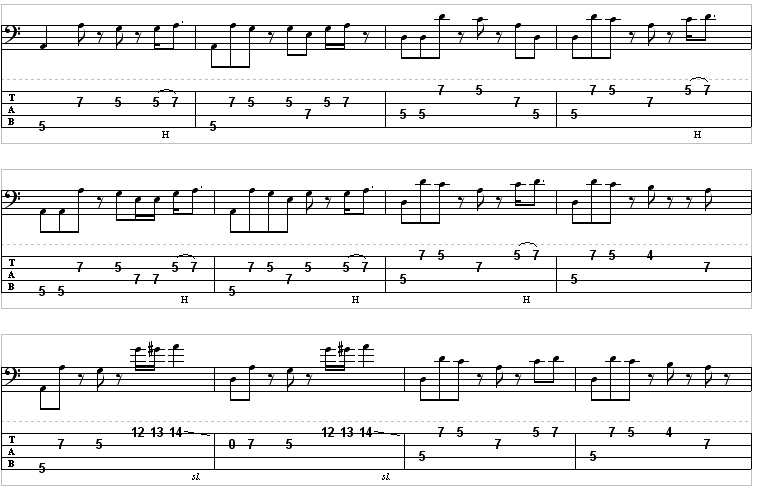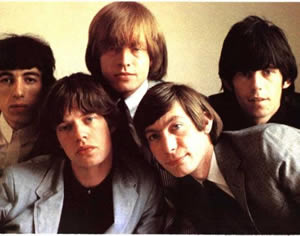The Rolling Stones had pioneered the gritty, hard-driving blues-based rock & roll that came to define hard rock. With his macho attitude and extreme maliciousness, Mick Jagger became the stereotypical ( no pun intended) rock frontman, tempering his macho showmanship with a detached, lucid reality, Keith ( Keef) Richards surged forth as one of rock music’s ” man you wanted to be” due to his rebelliously intense guitar styling.
Intro
Here’s what the intro riff sounds like with both guitars and bass:
Guitar 1



This part of the riff is FULL of pretty much all of the techniques you will use when playing the guitar. These include: hammer-ons, pull-offs, slides, bends, and even mutes. What you will want to do here is pay close attention to how the techniques interact with each other to produce a note. Begin the first measure by either using your 1st and 3rd finger, or your 1st and 4th finger, depending on your comfort with your 4th finger. First, you will need to place your 1st finger on the fifth fret on the “G” string. Then, you will need to hammer-on to the seventh fret with either your 3rd or 4th finger on the same string. When we say hammer-on, we mean that you do NOT play the string again after you have played it once on the fifth fret. You allow the natural sound of the guitar changing to another fret take its course. After you have played the seventh fret, without picking that note, let off of it and keep your 1st finger on the fifth fret on the same string. By doing that, you have just created a hammer-on. Then, move your 3rd or 4th finger to the “D” string on the seventh fret. Here, you will play that note, and then use your 1st finger to play the fifth fret on the same string. By only striking the string once on the seventh fret and then moving your 1st finger to the fifth fret, you are creating a pull-off. Hammer-ons and pull-offs are polar opposites, but both produce the same effect. ( One note going higher to lower and one going lower to higher ).
After you have played the fifth fret with your 1st finger, simply take that finger off the fret board, and make sure that you left your 3rd or 4th finger in its starting position on the seventh fret on the “D” string. Then, you just end the measure by playing the fifth and then the seventh frets on the same string, using the same fingers that you did when starting out.
For the beginning of the second measure, notice that you are primarily doing the same thing that you did in the beginning, but you are adding an extra pull-off in there. Just adjust accordingly. At the end of the measure, you will be sliding. You will be using your 3rd and 4th fingers for this. Keep the two fingers in the same position, and place your 3rd finger on the sixth fret on the “B” string and your 4th finger on the seventh fret on the “G” string. Then, all you have to do is move to the appropriate frets.
For the third measure, which transitions from the second measure, you will need to create a quick mute on the “G” string. Do that by not playing on ANY fret, and just allow your pick to barely play that string. For the fourth measure, use your 1st finger to hammer-on from the fifth fret to the seventh fret with your 3rd or 4th finger on the “G” string. Then, use your 3rd or 4th finger on the “D” string to play the seventh fret. For the end of the measure, all you need to do is play just as you did at the end of the first measure, but allow the notes to hammer-on. FOr the fifth measure, allow that string to bend as you hear it in the audio. That will be a 1/4 bend on the seventh fret. Notice the small “5” on the tablature. That denotes that you will begin picking on the fifth fret, but actually bend on the seventh fret.
The sixth measure is just modified a little from the second measure. For the eighth measure, notice that you are basically picking out the slides from the second measure. The only change that you will see is on the “high E” string on the fifth fret. Just use your 1st finger to play that.
In the ninth measure, all you have to do is place your 3rd or 4th finger on the seventh fret on the “D” string, while playing the “A” string open. Then, barre your 1st finger on the fifth fret on the “B” string and the “high E” string. Hammer-on to the eighth fret with either your 3rd or 4th finger on the “B” string.
In the tenth measure, use your 3rd or 4th finger to play the eighth fret on the “high E” string and slide to the tenth fret on the same string with the same finger. Then, move that finger to the “B” string on the tenth fret and shake the string rapidly. That is called a vibrato. End the measure by sliding toward the tuning pegs on your guitar, not striking any particular note. You will almost be muting the string. For the eleventh measure, you will just be barring your 1st finger on the “D” string to the “high E” string. Then, place your 4th finger on the seventh fret on the “D” string, and your 3rd finger on the sixth fret on the “B” string. The rest of the measure is picked out in the same arrangement. For the last measure, just do what you have done for the eleventh measure, and when you see the eighth fret on the “high E” string, just use your 4th finger.
Guitar 2


This part is MUCH easier. Begin the measure by hammering-on from the open “G” string to the second fret on the same string. Your 1st finger is the best bet. End the measure by playing the “D” string open. For the second measure, use your 1st finger to play the second frets on the “D” string and the “G” string, and go ahead and place your 3rd and 4th fingers on the fifth fret on the “B” and “high E” strings. Then, end the measure by just moving your 3rd and 4th fingers one string and barre your 4th finger on the fifth frets on the “B” string and the “high E” string. Your 3rd finger will cover the fifth fret on the “G” string. The rest of these measures are self-explanatory and are relevant to the positionings that you have already done.
Bass Guitar

The bass part is mostly repetitive and you will be using your fingers in a logical walking manner on the fret board. For the lower numbers, use your 1st and/or 2nd fingers. For the higher numbers, use your 3rd and/or 4th fingers. Hammers will be treated the same way for the bass as they were the guitar.

